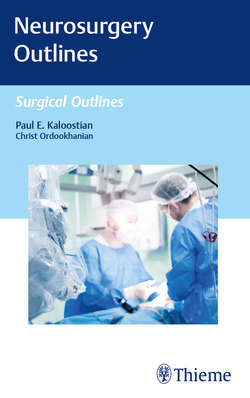Читать книгу Neurosurgery Outlines - Paul E. Kaloostian - Страница 86
На сайте Литреса книга снята с продажи.
Treatment Options
Оглавление• Acute pain control with medications and pain management
• Physical therapy and rehabilitation
• If symptomatic with cord compression:
– Urgent surgical decompression and fusion over implicated segments if deemed suitable candidate for surgery
– If poor surgical candidate with poor life expectancy, medical management recommended
– Surgery may be done anteriorly, posteriorly, or combined two-stage approach for added stabilization
– May include a combination of the following techniques: Laminectomy (entire lamina, thickened ligaments, and part of enlarged facet joints removed to relieve pressure), Laminotomy (section of lamina and ligament removed), Foraminotomy (expanding space of neural foramen by removing soft tissues, small disk fragments, and bony spurs in the locus), Laminoplasty (expanding space within spinal canal by repositioning lamina), Diskectomy (removal of section of herniated disk), Corpectomy (removal of vertebral body and disks), Bony Spur Removal
– Thoracic Decompression/Fusion Approaches:
• Anterior transthoracic (see ▶Fig. 2.8):
– Excellent exposure to anterior thoracic spine, vertebral bodies, intervertebral disks, spinal canal, and nerve roots
– Posterior elements and contralateral pedicle inaccessible
– No extensive bone resection or corpectomy
– Can freely use hemostatic agents in locus of bone removal since lateral fusion is performed
– Do not perform if there is displacement of posterior bone elements into spinal canal or when posterior penetrating injury exists (unless as part of a combined procedure)
– T2–T9 is preferentially approached from the right side to avoid injury to heart, aortic arch, and great vessels
Fig. 2.8 Illustration of different approaches to the thoracic spine. The transsternal approach allows anterior access to the upper thoracic. (Source: Thoracic spine. In: Vialle L, ed. AOSpine Masters Series, Volume 1: Metastatic Spinal Tumors. 1st ed. Thieme; 2014).
– T10–L2 is preferentially approached from the left side to avoid injury to liver
• Anterior transsternal (see ▶Fig. 2.9):
– Direct anterior exposure of thoracic spine
– Excellent for upper thoracic access and cervicothoracic exposure
